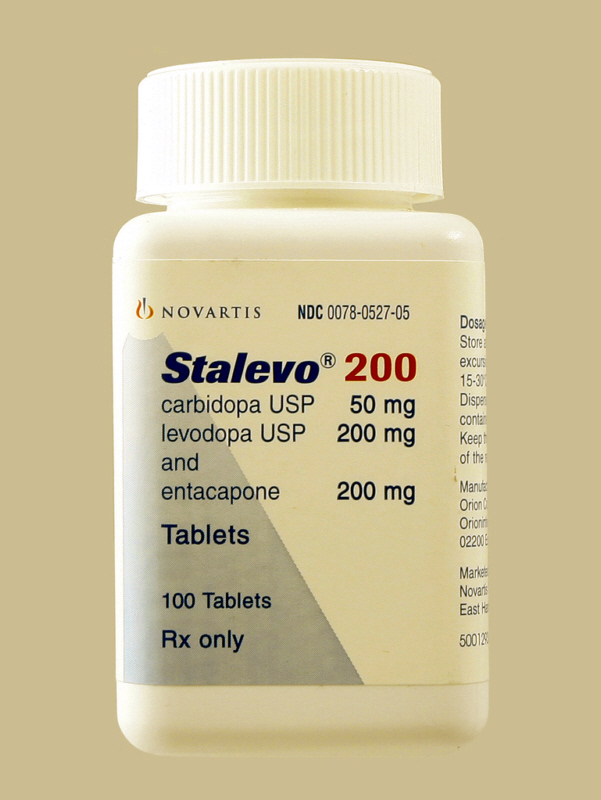28th September 2014 - New research
WEARING OFF IN PARKINSON'S DISEASE
|
�CLICK HERE
FOR A
PRINTABLE OR WHITE BACKGROUND VERSION OF THIS ARTICLE |
Parkinsonism Related Disorders [2014] 20 (2) : 204-211 (F.Stocchi,
A.Antonini, P.Barone, M.Tinazzi, M.Zappia, M.Onofrj, S.Ruggieri, L.Morgante,
U.Bonuccelli, L.Lopiano, P. Pramstaller, A.Albanese, M.Attar, V.Posocco,
D.Colombo, G.Abbruzzese)
Complete abstract
Wearing off of the effect of drugs for Parkinson's Disease has been found to
occur far earlier and in more people with Parkinson's Disease than
previously assumed. Wearing off is very individual and there is no standard
time frame for when this may occur or which symptoms are experienced. For more
information go to
Wearing off
 Neurologists
found that there was wearing off in 57% of people with Parkinson's Disease.
However, when this was assessed by the patients themselves, there was found
to be wearing off in 67% of people with Parkinson's Disease. Even in people
who had Parkinson's Disease for less than 2.5 years there was wearing off in
21% of people when assessed by neurologists and in 41% when patients
assessed themselves. The most frequent wearing off symptoms were slowness of
movements (55%) and reduced dexterity (48%). Those factors most associated
with wearing off were : younger age, female gender, severer symptoms, and
duration of treatment.
Neurologists
found that there was wearing off in 57% of people with Parkinson's Disease.
However, when this was assessed by the patients themselves, there was found
to be wearing off in 67% of people with Parkinson's Disease. Even in people
who had Parkinson's Disease for less than 2.5 years there was wearing off in
21% of people when assessed by neurologists and in 41% when patients
assessed themselves. The most frequent wearing off symptoms were slowness of
movements (55%) and reduced dexterity (48%). Those factors most associated
with wearing off were : younger age, female gender, severer symptoms, and
duration of treatment.
Wearing Off is already common in the early stages of Parkinson's Disease and
is underestimated by routine neurological clinical evaluation. The effect of
Parkinson's Disease drugs is therefore often relatively short lived.
In order to refer to this article on its own
click here
�
25th September 2014 - New Audiobook
PUT ON YOUR PARKY FACE ! THE EXPANDED VERSION
Bill Schmalfeldt
|
�CLICK HERE
FOR A
PRINTABLE OR WHITE BACKGROUND VERSION OF THIS ARTICLE |
 Publisher's
description : Put on your Parky face is a narrated Audiobook about
Parkinson's Disease by widely known Parkinson's Disease blogger Bill
Schmalfeldt. Bill is serving notice. It's time for Parkinson's disease patients
to stop being invisible. It's time for a nationwide effort to raise awareness
about this crippling degenerative neurological disorder and the havoc it wreaks.
Having had Parkinson's Disease since 2000 at the age of 45, Bill volunteered for
experimental brain surgery in 2007. He spins a humorous, poignant, and sometimes
angry tale about his life with this progressive neurological
condition. He uses his time, focus and energy to help fund the research that
will find the cure. 100% of the author proceeds from this book will be donated
to Parkinson's research charities.
On the web site there is a good audio sample.
Click here for more details�
�In order to refer to this article on its own
click here
Publisher's
description : Put on your Parky face is a narrated Audiobook about
Parkinson's Disease by widely known Parkinson's Disease blogger Bill
Schmalfeldt. Bill is serving notice. It's time for Parkinson's disease patients
to stop being invisible. It's time for a nationwide effort to raise awareness
about this crippling degenerative neurological disorder and the havoc it wreaks.
Having had Parkinson's Disease since 2000 at the age of 45, Bill volunteered for
experimental brain surgery in 2007. He spins a humorous, poignant, and sometimes
angry tale about his life with this progressive neurological
condition. He uses his time, focus and energy to help fund the research that
will find the cure. 100% of the author proceeds from this book will be donated
to Parkinson's research charities.
On the web site there is a good audio sample.
Click here for more details�
�In order to refer to this article on its own
click here
�
19th September 2014 - New research
TOZADENANT CLINICAL TRIALS FOR PARKINSON'S DISEASE
|
�CLICK HERE
FOR A
PRINTABLE OR WHITE BACKGROUND VERSION OF THIS ARTICLE |
Lancet Neurology [2014] 13 (8) : 767-776 (R.A.Hauser, C.W.Olanow,
K.D.Kieburtz, E. Pourcher, A.Docu-Axelerad, M.Lew, O.Kozyolkin, A.Neale,
C.Resburg, U.Meya, C.Kenney, S.Bandak)�
Complete abstract
Clinical trials assessed the use 60mg, 120mg, 180mg, or 240mg tozadenant in
people with Parkinson's Disease who were being treated with L-dopa and who
had motor fluctuations that involved at least 2�5 hours off-time per day.
Tozadenant (SYN115) is an inhibitor of the adenosine 2a (A2a) receptor that
is being developed for the treatment of Parkinson's Disease. For more
information go to
SYN115
 Compared
with the use of a placebo, daily off-time was reduced by more than an hour
when taking either 120mg or 180mg tozadenant. The most common adverse events
were dyskinesia (16% of people taking 120mg, 20% of people taking 180mg),
nausea (11% of people taking 120mg, 12% of people taking 180mg), dizziness
(5% of people taking 120mg, 13% of people taking 180mg). Tozadenant, 60 mg
twice daily, was not associated with a significant reduction in off-time.
Tozadenant, 240 mg twice daily, was associated with an increased rate of
discontinuation because of adverse events that occurred in 20% of people
taking that dosage.
Compared
with the use of a placebo, daily off-time was reduced by more than an hour
when taking either 120mg or 180mg tozadenant. The most common adverse events
were dyskinesia (16% of people taking 120mg, 20% of people taking 180mg),
nausea (11% of people taking 120mg, 12% of people taking 180mg), dizziness
(5% of people taking 120mg, 13% of people taking 180mg). Tozadenant, 60 mg
twice daily, was not associated with a significant reduction in off-time.
Tozadenant, 240 mg twice daily, was associated with an increased rate of
discontinuation because of adverse events that occurred in 20% of people
taking that dosage.
The researchers concluded that Tozadenant at 120 or 180 mg twice daily
was generally well tolerated and was effective at reducing off-time. Further
investigation of tozadenant treatment in phase 3 trials is warranted.
In order to refer to this article on its own
click here
�
11th September 2014 - New research
ENTACAPONE EFFICACY IN PARKINSON'S DISEASE
|
�CLICK HERE
FOR A
PRINTABLE OR WHITE BACKGROUND VERSION OF THIS ARTICLE |
Acta Neurologica Scandinavica [2014] Sep 3 [Epub ahead of print]
(M.Kuoppam�ki, M. Vahteristo, J.Ellm�n, K.Kieburtz)
Complete abstract
A retrospective analysis of randomised, double-blind, placebo-controlled
clinical trials of entacapone show that it improves Parkinson's Disease
symptoms but often at the expense of dyskinesia or nausea. Entacapone is
marketed as Comtan. In combination with L-dopa and carbidopa (the active
constituents of Sinemet) Entacapone is marketed as Stalevo. For more
information go to
Comtan
 Entacapone
improved daily OFF and ON times by 0.8 hours (48 minutes) compared with a
placebo. People taking entacapone also did better in the standard
Parkinson's Disease symptom questionnaire the UPDRS II, UPDRS III, and also
global evaluation. Similar benefits of entacapone were seen in subgroups of
patients with and without dopamine agonists or selegiline. Entacapone was
generally well tolerated. Dyskinesia and nausea were more frequently
reported by people taking entacapone, with 25% getting dyskinesia and 14%
getting nausea. There was no difference in reports of hallucinations.
Entacapone
improved daily OFF and ON times by 0.8 hours (48 minutes) compared with a
placebo. People taking entacapone also did better in the standard
Parkinson's Disease symptom questionnaire the UPDRS II, UPDRS III, and also
global evaluation. Similar benefits of entacapone were seen in subgroups of
patients with and without dopamine agonists or selegiline. Entacapone was
generally well tolerated. Dyskinesia and nausea were more frequently
reported by people taking entacapone, with 25% getting dyskinesia and 14%
getting nausea. There was no difference in reports of hallucinations.
The researchers suggest that results of this pooled analysis of
entacapone clinical trials potentially serve as a useful benchmarking data
for new therapies, especially those including L-dopa, in people with
advanced Parkinson's Disease.
In order to refer to this article on its own
click here
�
8th September� 2014 - News release
SUBCUTANEOUS LIQUID L-DOPA FOR PARKINSON'S DISEASE
|
�CLICK HERE
FOR A
PRINTABLE OR WHITE BACKGROUND VERSION OF THIS ARTICLE |
NeuroDerm have announced that the first patients with severe Parkinson's
Disease have been enrolled and dosed in a Phase IIa trial of ND0612H.
ND0612H is a high-dose form of liquid L-dopa and carbidopa (which is the
same as Sinemet) but which is delivered continuously through subcutaneous
administration (via the skin) by a belt-pump. Unlike the most comparable
methods of administering L-dopa, no surgery at all is needed.
ND0612H is intended to replace current treatments for people with severe
Parkinson's Disease that require highly invasive surgery that is associated
with serious side effects.
 ND0612L
is the low dose drug form intended for moderate Parkinson's Disease. ND0612L
has just completed patient enrolment and treatment in a Phase II
double-blind, randomised, placebo-controlled study. ND0612L was shown in
previous phase I and phase IIa studies to be safe and tolerable, reaching
steady state, clinically meaningful L-dopa blood concentrations.
ND0612L
is the low dose drug form intended for moderate Parkinson's Disease. ND0612L
has just completed patient enrolment and treatment in a Phase II
double-blind, randomised, placebo-controlled study. ND0612L was shown in
previous phase I and phase IIa studies to be safe and tolerable, reaching
steady state, clinically meaningful L-dopa blood concentrations.
ND0612L and ND0612H are the first liquid formulations of L-dopa and
carbidopa to be administered subcutaneously (via the skin) to conveniently
achieve steady state L-dopa plasma levels. L-dopa and carbidopa are
otherwise nearly always administered orally, which can cause motor
fluctuations and non-motor complications in Parkinson's Disease.
For more information go to
NeuroDerm
In order to refer to this article on its own
click here
�
.gif)
.gif)
 Neurologists
found that there was wearing off in 57% of people with Parkinson's Disease.
However, when this was assessed by the patients themselves, there was found
to be wearing off in 67% of people with Parkinson's Disease. Even in people
who had Parkinson's Disease for less than 2.5 years there was wearing off in
21% of people when assessed by neurologists and in 41% when patients
assessed themselves. The most frequent wearing off symptoms were slowness of
movements (55%) and reduced dexterity (48%). Those factors most associated
with wearing off were : younger age, female gender, severer symptoms, and
duration of treatment.
Neurologists
found that there was wearing off in 57% of people with Parkinson's Disease.
However, when this was assessed by the patients themselves, there was found
to be wearing off in 67% of people with Parkinson's Disease. Even in people
who had Parkinson's Disease for less than 2.5 years there was wearing off in
21% of people when assessed by neurologists and in 41% when patients
assessed themselves. The most frequent wearing off symptoms were slowness of
movements (55%) and reduced dexterity (48%). Those factors most associated
with wearing off were : younger age, female gender, severer symptoms, and
duration of treatment. Publisher's
description : Put on your Parky face is a narrated Audiobook about
Parkinson's Disease by widely known Parkinson's Disease blogger Bill
Schmalfeldt. Bill is serving notice. It's time for Parkinson's disease patients
to stop being invisible. It's time for a nationwide effort to raise awareness
about this crippling degenerative neurological disorder and the havoc it wreaks.
Having had Parkinson's Disease since 2000 at the age of 45, Bill volunteered for
experimental brain surgery in 2007. He spins a humorous, poignant, and sometimes
angry tale about his life with this progressive neurological
condition. He uses his time, focus and energy to help fund the research that
will find the cure. 100% of the author proceeds from this book will be donated
to Parkinson's research charities.
On the web site there is a good audio sample.
Publisher's
description : Put on your Parky face is a narrated Audiobook about
Parkinson's Disease by widely known Parkinson's Disease blogger Bill
Schmalfeldt. Bill is serving notice. It's time for Parkinson's disease patients
to stop being invisible. It's time for a nationwide effort to raise awareness
about this crippling degenerative neurological disorder and the havoc it wreaks.
Having had Parkinson's Disease since 2000 at the age of 45, Bill volunteered for
experimental brain surgery in 2007. He spins a humorous, poignant, and sometimes
angry tale about his life with this progressive neurological
condition. He uses his time, focus and energy to help fund the research that
will find the cure. 100% of the author proceeds from this book will be donated
to Parkinson's research charities.
On the web site there is a good audio sample.
 Compared
with the use of a placebo, daily off-time was reduced by more than an hour
when taking either 120mg or 180mg tozadenant. The most common adverse events
were dyskinesia (16% of people taking 120mg, 20% of people taking 180mg),
nausea (11% of people taking 120mg, 12% of people taking 180mg), dizziness
(5% of people taking 120mg, 13% of people taking 180mg). Tozadenant, 60 mg
twice daily, was not associated with a significant reduction in off-time.
Tozadenant, 240 mg twice daily, was associated with an increased rate of
discontinuation because of adverse events that occurred in 20% of people
taking that dosage.
Compared
with the use of a placebo, daily off-time was reduced by more than an hour
when taking either 120mg or 180mg tozadenant. The most common adverse events
were dyskinesia (16% of people taking 120mg, 20% of people taking 180mg),
nausea (11% of people taking 120mg, 12% of people taking 180mg), dizziness
(5% of people taking 120mg, 13% of people taking 180mg). Tozadenant, 60 mg
twice daily, was not associated with a significant reduction in off-time.
Tozadenant, 240 mg twice daily, was associated with an increased rate of
discontinuation because of adverse events that occurred in 20% of people
taking that dosage.  Entacapone
improved daily OFF and ON times by 0.8 hours (48 minutes) compared with a
placebo. People taking entacapone also did better in the standard
Parkinson's Disease symptom questionnaire the UPDRS II, UPDRS III, and also
global evaluation. Similar benefits of entacapone were seen in subgroups of
patients with and without dopamine agonists or selegiline. Entacapone was
generally well tolerated. Dyskinesia and nausea were more frequently
reported by people taking entacapone, with 25% getting dyskinesia and 14%
getting nausea. There was no difference in reports of hallucinations.
Entacapone
improved daily OFF and ON times by 0.8 hours (48 minutes) compared with a
placebo. People taking entacapone also did better in the standard
Parkinson's Disease symptom questionnaire the UPDRS II, UPDRS III, and also
global evaluation. Similar benefits of entacapone were seen in subgroups of
patients with and without dopamine agonists or selegiline. Entacapone was
generally well tolerated. Dyskinesia and nausea were more frequently
reported by people taking entacapone, with 25% getting dyskinesia and 14%
getting nausea. There was no difference in reports of hallucinations. ND0612L
is the low dose drug form intended for moderate Parkinson's Disease. ND0612L
has just completed patient enrolment and treatment in a Phase II
double-blind, randomised, placebo-controlled study. ND0612L was shown in
previous phase I and phase IIa studies to be safe and tolerable, reaching
steady state, clinically meaningful L-dopa blood concentrations.
ND0612L
is the low dose drug form intended for moderate Parkinson's Disease. ND0612L
has just completed patient enrolment and treatment in a Phase II
double-blind, randomised, placebo-controlled study. ND0612L was shown in
previous phase I and phase IIa studies to be safe and tolerable, reaching
steady state, clinically meaningful L-dopa blood concentrations.